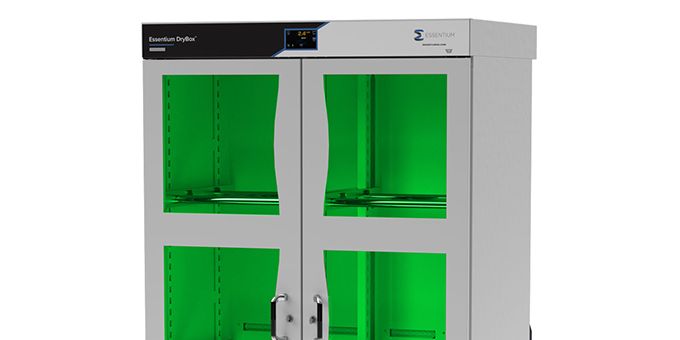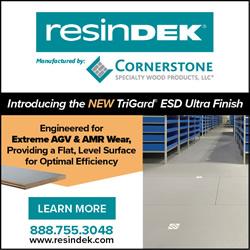Here's some guidance on best practices for material handling and advice on the proper equipment to implement a material handling workflow at your facility.
 Material Handling Guidance for Additive Manufacturers from Essentium
Material Handling Guidance for Additive Manufacturers from Essentium

Brandon Sweeney, Executive Vice President of R&D Materials and Co-founder | Essentium
Today’s industrial 3D printing manufacturers demand the freedom and flexibility to operate their additive manufacturing equipment in the same way they operate their injection molding and CNC machining equipment. With that freedom, however, come the challenges of proper material handling that is paramount for consistent results from printed parts.
Challenges stem from a lack of education and knowledge transfer from the plastic processing community to the 3D printing community, as well as the lack of specialized equipment that specifically addresses the material handling needs of filament-based material extrusion 3D printers.
Here's some guidance on best practices for material handling and advice on the proper equipment to implement a material handling workflow at your facility.
Challenges of Moisture in Polymers
Common indicators of wet filament are excessive stringing or a rough surface finish due to dramatic changes in the polymer viscosity (water can act as a plasticizer for certain polymers). Other changes caused by the presence of moisture are invisible. Polycondensation polymers including polyester (PETG, PCTG, PLA), polyamide (nylons), polyether (POM), and polycarbonate are susceptible to hydrolytic degradation. If the material is heated (especially during melt processing) in the presence of excess moisture, the polymer chains are physically chopped (chain scission) into lower molecular weight segments. This has a dramatic negative effect on impact resistance, elongation at break, toughness, and strength, and highlights the importance of keeping materials dry during storage and while feeding material to a printer.
Moisture In, Moisture Out
Moisture is introduced to polymers in two primary ways: absorption and adsorption. Absorption is the diffusion of water molecules into the volume of polar polymers. Adsorption is the adhesion of water molecules to the surface of a polymer and can affect both polar and non-polar polymers. The vast majority of thermoplastic polymers used in material extrusion 3D printing are polar and hygroscopic – that is, they both absorb and adsorb moisture from ambient air.
The same mechanism by which moisture makes its way into a polymer is the way to get it back out and dry it. Moisture originally diffused into the polymer because the concentration gradient was high for humid ambient air to diffuse into the dry polymer. To drive the diffusion process backward, you must reverse the concentration gradient: place the moisture laden polymer into a dry ambient environment. This is typically accomplished in one of three ways: hot air drying, desiccant air drying, or vacuum drying.
Procedures to Keep Materials Dry
It is very important to dry each polymer type at the appropriate temperature and time recommended by the manufacturer. The best way to avoid over drying material is to have a material handling procedure that minimizes the introduction of moisture into the resin in the first place.
For example, when you receive new material, you should keep the spool sealed until the moment you are ready to load it into a dry canister for printing. When you are ready to print, the material should be transferred from the vacuum sealed packing to the canister as fast as possible in a dry, airconditioned area, under one minute is ideal. Always avoid situations where a spool at a lower temperature is opened or transferred in a hotter and more humid environment to avoid condensation of moisture onto the filament.
If a spool of material is used quickly enough after being loaded into a dry container, then the process ends there. This is a sufficient quality control process for keeping material dry and will yield more consistent quality in prints. If the material needs to be exchanged for another material type or a spool with more material to complete another print, it is best to either leave the material in the dry container (necessitating multiple dry containers for a regular workflow) or to transfer it to a larger dry storage container like the Essentium DryBox™.
If a material is left in a “dry” container for a period of weeks or months, it still may slowly pick up moisture that diff uses into the container, and for highly hygroscopic resins it may be best to re-dry the spool in an oven prior to use. The only way to truly know the state of the spool is to test moisture content with a loss of mass (LOM), moisture-specific, or Karl Fisher titration moisture analyzer.
Drying Material is Often a Balancing Act
The same polymers that hydrolytically degrade in the presence of excess moisture can also be overdried, which negatively influences processing and final properties. Trace amounts of moisture in polyamides can act as a plasticizer and effectively reduce the melt viscosity of the resin to yield better part quality. Other resins like polyester often have lower molecular weight plasticizers or processing aids that can be driven off by excessive drying.
If a spool does go above the recommended moisture limits for the material, it should be dried with proper equipment. For low criticality materials where only cosmetic concerns apply, a convection oven may be sufficient to re-dry the filament; however, this is not best practice and may very well lead to degradation of the polymer, especially for long drying times.
Unfortunately, small-scale desiccant dryers that meet the needs of additive manufacturing are difficult to find and can easily be ten times the price of an equivalent convection oven. We have seen some dryers come on the market that address this need, but their performance needs to be evaluated. For high performance thermoplastics that need to be dried above 100˚C, a vacuum oven can be the best solution for reduced drying times, gentler temperatures, and the lowest price point.
It is important to dry the material only for the recommended time and temperature provided by the material manufacturer. An oven is not an acceptable storage solution for material. Ovens with programmable time and temperature settings are preferable so that material is dried precisely the same way from batch to batch. Once a material is dry, it should be transferred back to the dry canister for feeding into the printer or placed in an appropriate dry holding container for later use.
If these controls and procedures are put into practice at your facility, we guarantee that you will see more consistent print results with better part quality. For more demanding applications it is essential that each facility adopt their own material handling procedures that are followed and documented.
ESSENTIUM DRYBOX
Essentium has partnered with industry-leading dry cabinet maker: Electronic Controls Design Inc. to release the next generation of Essentium's DryBox™ filament storage technology. The all new humidity-controlled cabinet is designed to have a humidity recovery time less than 5 minutes and can maintain relative humidity values under 1% (dew point under -40 ̊C). This means spools stored in the cabinet will stay dry longer than ever giving users the flexibility to swap materials as often as their workflow requires. Available in two sizes the DB90 cabinet can accommodate up to 24 - 750 g spools, 8 - 2.5 kg spools or 6 - 15 kg spools, and the DB270 cabinet can accommodate up to 72 - 750 g spools, 24 - 2.5 kg spools or 18 - 15 kg spools. The Essentium DryBox is Industry 4.0 ready with a dedicated digital touch screen interface for setting desired dry storage parameters, intelligent LED interior status lighting, onboard data logging and network connectivity.
The content & opinions in this article are the author’s and do not necessarily represent the views of ManufacturingTomorrow
Comments (0)
This post does not have any comments. Be the first to leave a comment below.
Featured Product

